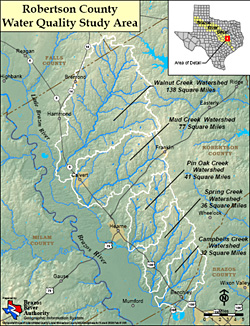Project Background
The central watershed of the Brazos River consists of one classified water body, the Brazos River above Navasota River (Segment 1242), and a number of unclassified waterbodies on tributary systems. This segment extends from the Lake Brazos Dam in Waco 183 miles downstream to its confluence with the Navasota River southeast of College Station and its watershed encompasses approximately 2,705 mi2. With the exception of the Waco and Bryan/College Station urban areas, land use in the watershed is generally agricultural with a few large industrial facilities and quarries.
 In 2002, a water quality data analysis determined that eight unclassified water bodies within the central watershed had bacteria concentrations that exceed state water quality standards for contact recreation. As a result, these waterbodies were placed on the Texas §303(d) List of Impaired Waters. Three additional unclassified segments were added to the 2006 §303(d) List bringing the total number of water quality impairments (bacteria) on segment 1242 to eleven.
In 2002, a water quality data analysis determined that eight unclassified water bodies within the central watershed had bacteria concentrations that exceed state water quality standards for contact recreation. As a result, these waterbodies were placed on the Texas §303(d) List of Impaired Waters. Three additional unclassified segments were added to the 2006 §303(d) List bringing the total number of water quality impairments (bacteria) on segment 1242 to eleven.
Of those waterbodies impaired for bacteria, five are located within a very close proximity of each other in Robertson County and share similar land use and water quality characteristics. In addition, they are all tributaries to the Little Brazos River (Segment 1242E). The five waterbodies in the study area for this project are Campbells Creek (Segment 1242I), Mud Creek (Segment 1242K), Pin Oak Creek (Segment 1242L), Spring Creek (Segment 1242M), and Walnut Creek (Segment 1242O). The study area encompasses 327 mi2, almost entirely within Robertson County. The land use in the area is primarily agricultural, range and pastureland with mixed areas of cultivated cropland, with several small communities.
The 2006 §303(d) List identifies all five segments in the study area as Category 5c, meaning that the waterbody does not meet applicable water quality standards for one or more designated uses by one or more pollutants and that additional data and information will be collected before a Total Maximum Daily Load (TMDL) is scheduled.
The Texas Commission on Environmental Quality (TCEQ and the Texas State Soil and Water Conservation Board (TSSWCB) established a joint, technical Task Force on Bacteria TMDLs in September 2006 charged with making recommendations on cost-effective and time-efficient bacteria TMDL development methodologies. The Task Force recommended the use of a three-tier approach that is designed to be scientifically credible and accountable to watershed stakeholders. The tiers move through increasingly aggressive levels of data collection and analysis in order to achieve stakeholder consensus on needed load reductions and strategies to achieve those reductions. In June 2007, the TCEQ and the TSSWCB adopted the the principles and general process recommended by the Task Force and directed agency staff to incorporate the principles of the recommendations into an updated joint-agency TMDL guidance document.
In accordance with the Memorandum of Agreement Between the TCEQ and the TSSWCB Regarding TMDLs, Implementation Plans, and Watershed Protection Plans, the TSSWCB has agreed to take the lead role in addressing the bacteria impairments for the five segments in the study area. Through this project, the TSSWCB and the Brazos River Authority (BRA) will work with local stakeholders to progress through the data collection and analysis components of the first two tiers of the Task Force recommended three-tier approach.